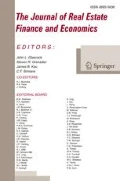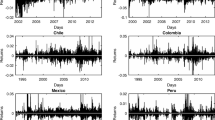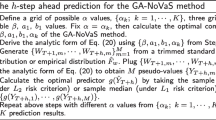Abstract
This study compares the relative performance of several well-known models in the forecasting of REIT volatility. Overall our results suggest that long-memory models (ARFIMA & FIGARCH) provide the best forecasts. Using either a large sample or some statistically justified small subsamples, we find that long memory models consistently outperform their short-memory counterparts (GARCH & Stochastic Volatility models) over a variety of forecast horizons. We also find that asymmetric models (EGARCH & FIEGARCH) are the worst performers among all models. Our study complements and extends a recent study of Cotter and Stevenson (2008) which demonstrates the usefulness of long-memory models in modeling REIT volatility. We conclude that in addition to modeling REIT volatility, long-memory models should also be adopted to forecast REIT volatility.


Similar content being viewed by others
Notes
For instance, in February 2007 the Chicago Board of Trade launched its new futures contract based on the Dow Jones U.S. Real Estate Index (DJUSRE). As of March 31, 2007, the DJUSRE Index included 91 constituents, of which 85 were REITs. The DJUSRE Index futures contract trades electronically six days a week, and has a value equal to 100 multiplied by the value of the DJUSRE.
The distribution of REIT returns is estimated using the Kernel density estimation method.
In this paper, we use the Ox software to estimate the models and perform the forecasting.
The forecast period ends on 04/11/2008. Due to the construction method, the last RV that can be generated is for 04/11/2008, which is 22 days prior to 04/30/2008, the ending date of our data sample.
There are only 246 5-day ahead forecasts (05/04/2007-04/11/2008) because the first forecast we can obtain is for 05/04/2007. It occurs when the rolling window is fixed at the first 2100 observations (01/05/1999 to 04/30/2007). In a similar reasoning, for 10-, 15-, 20-, and 25-day horizons, we generate 241, 236, 231, and 226 forecasts, respectively.
We are indebted to an anonymous reviewer for bringing attention to this point.
Applying this procedure to the historical volatility (HV) also yields two break points—7/10/2002 and 5/11/2006. Compared with the two break points generated from realized volatility (RV), the first one is very close and the second one is actually the same.
Using the three subsamples defined by the two break points generated from the historical volatility (HV), we obtain very similar forecasting results. To conserve space, they are not shown here but are available upon request.
References
Andersen, T., & Sørensen, B. (1996). GMM Estimation of a Stochastic Volatility Model: A Monte Carlo Study. Journal of Business and Economics Statistics, 14, 329–52.
Andersen, T. G., & Bollerslev, T. (1997a). Heterogeneous Information Arrivals and Return Volatility Dynamics: Uncovering the Long-run in High Frequency Returns. Journal of Finance, 52, 975–1005.
Andersen, T. G., & Bollerslev, T. (1997b). Intraday Periodicity and Volatility Persistence in Financial Markets. Journal of Empirical Finance, 4, 115–58.
Bai, J., & Perron, P. (1998). Estimating and Testing Linear Models with Multiple Structural Changes. Econometrica, 66, 47–78.
Bai, J., & Perron, P. (2003). Computation and Analysis of Multiple Structural Change Models. Journal of Applied Econometrics, 18, 1–22.
Baillie, R. T., Bollerslev, T., & Mikkelsen, H. O. (1996). Fractionally Integrated Generalized Conditional Heteroskedasticity. Journal of Econometrics, 74, 3–30.
Barkham, R., & Geltner, D. (1995). Price discovery in American and British property markets. Real Estate Economics, 23, 21–44.
Bollerslev, T. (1986). Generalized autoregressive conditional heteroskedasticity. Journal of Econometrics, 31, 307–327.
Bollerslev, T., & Mikkelsen, H. O. (1996). Modeling and pricing long memory in stock market volatility. Journal of Econometrics, 73, 151–184.
Bollerslev, T., & Mikkelsen, H. O. (1999). Long-Term Equity Anticipation Securities and Stock Market Volatility Dynamics. Journal of Econometrics, 92, 75–99.
Bredin, D., O’Reilly, G., & Stevenson, S. (2007). Monetary shocks and REIT returns. Journal of Real Estate Finance and Economics, 35, 315–31.
Brockwell, P. J., & Davis, R. A. (1991). Time Series: Theory and Methods. Spring-Verlag: New York.
Chandrashekaran, V. (1999). Time-series properties and diversification benefits of REIT returns. Journal of Real Estate Research, 17, 91–112.
Chui, A. C. W., Titman, S., & Wei, K. C. J. (2003). Intra-industry Momentum: the Case of REITs. Journal of Financial Markets, 6, 363–387.
Cotter, J., & Stevenson, S. (2006). Multivariate modeling of daily REIT volatility. Journal of Real Estate Finance and Economics, 32, 305–25.
Cotter, J., & Stevenson, S. (2008). Modeling long memory in REITs. Real Estate Economics, 36, 533–54.
Danielsson, J. (1994). Stochastic Volatility in Asset Prices: Estimation with Simulated Maximum Likelihood. Journal of Econometrics, 64, 375–400.
Devaney, M. (2001). Time-varying risk premia for real estate investment trusts: a GARCH-M model. Quarterly Review of Economics and Finance, 41, 335–46.
Ding, Z., Granger, C. W. J., & Engle, R. F. (1993). A Long Memory Property of Stock Returns. Journal of Empirical Finance, 1, 83–106.
Evans, T., & McMillan, D. G. (2007). Volatility Forecasts: the Role of Asymmetric and Long-memory Dynamics and Regional Evidence. Applied Financial Economics, 17, 1421–30.
Ewing, B. T., & Payne, J. E. (2005). The Response of Real Estate Investment Trust Returns to Macroeconomic Shocks. Journal of Business Research, 58, 293–300.
Ghysels, E., A. Harvey, and E. Renault. (1996). Stochastic Volatility. In Handbook of Statistics. Vol. 14: Statistical Methods in Finance, Maddala, G.S. (ed.) North-Holland, Amsterdam, pp. 119–91.
Gospodinov, N., Gavala, A., & Jiang, D. (2006). Forecasting Volatility. Journal of Forecasting, 25, 381–400.
Granger, C., & Joyeux, R. (1980). An Introduction to Long Memory Time Series Models and Fractional Differencing. Journal of Time Series Analysis, 1, 15–39.
Horng, Y. S. and P. H. Wei. (1999). An Empirical Study of Derivatives Use in the REIT Industry.Real Estate Economics, 27, 561–86.
Hosking, J. (1981). Fractional Differencing. Biometrika, 68, 165–76.
Jirasakuldech, B., Campbell, R. D., & Emekter, R. (2009). Conditional Volatility of Equity Real Estate Investment Trust Returns: A Pre- and Post-1993 Comparison. Journal of Real Estate Finance and Economics, 38, 137–54.
Kim, J. W., Leatham, D. J., & Bessler, D. A. (2007). REITs’ Dynamics under Structural Change with Unknown Break Points. Journal of Housing Economics, 16, 37–58.
Kim, S., Shephard, N., & Chib, S. (1998). Stochastic volatility: Likelihood Inference and Comparison with ARCH Models. Review of Economic Studies, 65, 361–93.
Lamoureux, C. G., & Lastrapes, W. D. (1990). Heteroskedasticity in Stock Return Data: Volume versus GARCH Effects. Journal of Finance, 45, 221–29.
Li, Y., & Wang, K. (1995). The predictability of REIT returns and market segmentation. Journal of Real Estate Research, 10, 471–82.
Ling, D., & Naranjo, A. (1999). The integration of commercial real estate markets and stock markets. Real Estate Economics, 27, 483–515.
Liu, C. H., Hartzell, D. J., Greig, W., & Grissom, T. (1990). The integration of the real estate market and the stock market: some preliminary evidence. Journal of Real Estate Finance and Economics, 3, 261–82.
Liu, C. H., & Mei, J. (1992). The predictability of returns on equity REITs and their co-movement with other assets. Journal of Real Estate Finance and Economics, 5, 401–18.
Liu, J., Wu, S., & Zidek, J. V. (1997). On Segmented Multivariate Regressions. Statistica Sinica, 7, 497–525.
Lobato, I. N., & Savin, N. E. (1998). Real and Spurious Long-Memory Properties of Stock-Market Data. Journal of Business and Economics Statistics, 16, 261–68.
Mei, J., & Lee, A. (1994). Is there a real estate risk premium? Journal of Real Estate Finance and Economics, 9, 113–26.
Myer, F. C. N., & Webb, J. R. (1994). Statistical properties of returns: financial assets versus commercial real estate. Journal of Real Estate Finance and Economics, 8, 267–82.
Nelson, D. B. (1989). Commentary: Price Volatility, International Market Links, and Their Implications for Regulatory Policies. Journal of Financial Services Research, 3, 113–48.
Nelson, D. B. (1991). Conditional Heteroskedasticity in Asset Returns: A New Approach. Econometrica, 59, 347–370.
Okunev, J., Wilson, P., & Zurbruegg, R. (2000). The Causal Relationship between Real Estate and Stock Markets. Journal of Real Estate Finance and Economics, 21, 251–261.
Poon, S. H., & Granger, C. W. J. (2003). Forecasting Volatility in Financial Markets: A Review. Journal of Economic Literature, 41, 478–539.
Poon, S. H. (2005). Forecasting Volatility in Financial Markets: A Practical Guide. John Wiley & Sons.
Ruiz, E. (1994). Quasi-maximum Likelihood Estimation of Stochastic Volatility Models. Journal of Econometrics, 63, 289–306.
Seiler, M. J., Webb, J. R., & Myer, F. C. N. (1999). Are EREITs real estate? Journal of Real Estate Portfolio Management, 5, 171–82.
Shephard, N. (1996). Statistical Aspects of ARCH and Stochastic Volatility Models. In D. R. Cox, D. V. Hinkley & O. E. Bandorff-Nielsen (Eds.), Time Series Models in Econometrics, Finance and Other Fields (pp. 1–67). London: Chapman & Hall.
So, M. K. P., Lam, K., & Li, W. K. (1999). Forecasting Exchange Rate Volatility Using Autoregressive Random Variance Model. Applied Financial Economics, 9, 583–91.
Sowell, F. B. (1992). Maximum Likelihood Estimation of Stationary Univariate Fractionally Integrated Time Series Models. Journal of Econometrics, 53, 165–188.
Stevenson, S. (2002). An examination of volatility spillovers in REIT returns. Journal of Real Estate Portfolio Management, 8, 229–38.
Taylor, S.J. (1982). Financial Returns Modeled by the Product of Two Stochastic Processes- A Study of Daily Sugar Prices, in Time Series Analysis: Theory and Practice 1, (Ed.) O. D. Anderson, North Holland, Amsterdam, pp. 203–26.
Taylor, S. J. (1986). Modeling Financial Time Series. Chichester: Wiley.
Winniford, M. (2003). Real Estate Investment Trusts and seasonal volatility: a periodic GARCH model, working paper, Duke University.
Yu, J. (2002). Forecasting Volatility in the New Zealand Stock Market. Applied Financial Economics, 12, 193–202.
Zeileis,A., A.Shah, and I.Patnaik. (2007). Exchange Rate Regime Analysis Using Structural Change Methods. Working Paper, Department of Statistics and Mathematics, Wien, Wirtschaftsuniv.
Zumbach, G. (2004). Volatility processes and volatility forecast with long memory. Quantitative Finance, 4, 70–86.
Author information
Authors and Affiliations
Corresponding author
Rights and permissions
About this article
Cite this article
Zhou, J., Kang, Z. A Comparison of Alternative Forecast Models of REIT Volatility. J Real Estate Finan Econ 42, 275–294 (2011). https://doi.org/10.1007/s11146-009-9198-7
Published:
Issue Date:
DOI: https://doi.org/10.1007/s11146-009-9198-7




